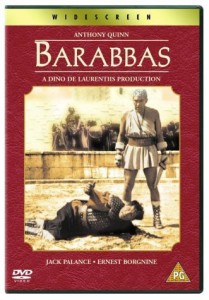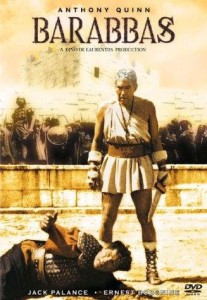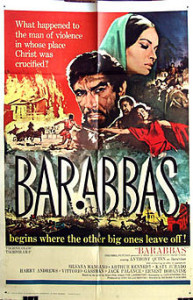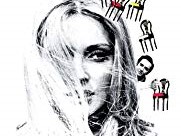Barabbas **** (1961, Anthony Quinn, Silvana Mangano, Arthur Kennedy, Harry Andrews, Ernest Borgnine, Vittorio Gassman, Jack Palance, Valentina Cortese, Katy Jurado) – Classic Movie Review 2,291
The exciting and inspirational 1961 biblical epic film Barabbas stars Anthony Quinn in a sterling performance as the robber-killer Barabbas, who is replaced on the cross by Jesus Christ and is spared crucifixion.
Director Richard Fleischer’s exciting and inspirational 1961 biblical epic film Barabbas stars Anthony Quinn in a sterling, steady and often stirring performance as the robber-killer Barabbas, who is replaced on the cross by Jesus Christ and is spared crucifixion when Pontius Pilate manipulates the crowd into to pardoning him, rather than Jesus.
[Spoiler alert] Later, haunted by the image of Jesus and struggling with his spirituality, Barabbas undergoes various ordeals, including in the gladiatorial arena, where he tries to win his freedom and confront his demons, that lead him to become a follower of Christ. The story has clear parallels with the one in the 1953 The Robe.
Italian producer Dino De Laurentiis’s impressive, expensive and good-looking religious sword and sandal movie is conceived as a grand Roman epic. It starts off with the inestimable benefit of a crisp and clear screenplay by Christopher Fry, Nigel Balchin, Diego Fabbri and Ivo Perilli, who cut an effective and incisive swathe through the complexities of Pär Lagerkvist’s 1950 Nobel Prize-winning novel. Lagerkvist’s novel expands on the career of Barabbas known from the Christian Passion narrative in the Gospel of Mark and other gospels.
Despite the film’s vast scale, visual sweep and obvious heartfelt sincerity, there are still times when it can seem thin, ponderous or clichéd, though this is a problem shared with most of the biblical epics of the period. However, the large and exceptional cast give committed and energetic performances that bring their characters and the story alive. And, just when the movie starts to sags, it is lifted up high again by exciting action scenes. As director, Fleischer keeps control over a tricky project.
Barabbas also stars Ernest Borgnine as Lucius, Vittorio Gassman as Sahak, Arthur Kennedy as Pontius Pilate, Norman Wooland as Rufio, Harry Andrews as Peter, Valentina Cortese as Julia and Katy Jurado as Sara. Alas, Silvana Mangano hasn’t much to go on as Quinn’s love Rachel and Jack Palance overdoes his turn as the nasty gladiator Torvald.
But Barabbas is an impressive movie, and ends up being only a couple of stages down from the epic movie heights of Ben-Hur and Spartacus.
Also in the case are Michael Gwynn (Lazarus), Ivan Triesault (Emperor), Douglas Fowley (Vasasio), Robert Hall (Commander of Gladiators), Lawrence Payne (Disciple), Arnoldo Foà (Joseph of Arimathea), Guido Celano (Scorpio) and Rocco Roy Mangano (the brother of Silvana Mangano and brother-in-law of Dino De Laurentiis), who appears as Christ.
Shot in Verona and Rome under De Laurentiis’s supervision, Barabbas includes many spectacular scenes, including a gladiator battle in the arena mocked up in the Rome Cinecittà film studio and a crucifixion shot during a real eclipse of the sun. The re-creation of Christ’s crucifixion was filmed on 15 February 1961 when a total eclipse of the sun, considered a supernatural event in the Judean age, took place. No pressure, there then, on filming day. Mario Nascimbene’s score is notable for its experimental electronic sounds. It’s these visual and aural components that make Barabbas remarkable and of enduring interest.
A previous film version of the novel in Swedish was made in 1953. It is remade as a 2012 TV mini-series with Billy Zane and Cristiana Capotondi.
The 18-year-old Sharon Tate makes her first appearance in a movie as Patrician in Arena (uncredited), six years before her two ‘introducing’ credited roles in Eye of the Devil and Don’t Make Waves. In her last film, Twelve Plus One [2 + 1] (1969), she was top billed over Barabbas star Vittorio Gassman.
© Derek Winnert 2015 Classic Movie Review 2,291
Check out more reviews on http://derekwinnert.com








